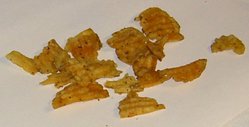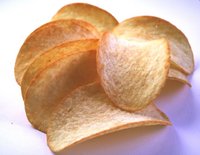Potato chips

Potato chips or crisps are a snack food made from potatoes cut into very thin slices, deep fried or baked until crisp, and then served. Commercial varieties are packaged for sale, usually in bags. The simplest chips are simply cooked and salted, but a wide variety of seasonings (mostly made using MSG and herbs or spices) are used to produce various 'seasoned' chips. Potato chips are an important part of the snack food market in English-speaking countries.
There is little consistency in the English speaking world for names of potato dishes. North American English uses chips for the above mentioned dish, and french fries for the chewier dish. In British English, crisps are used for the crispy dish and chips for the chewy dish (as in "fish and chips"). In Australia, New Zealand and South Africa, both forms of potato product are simply known as chips, as are the larger "home-style" potato chips. Kumara (sweet potato) chips are eaten in New Zealand.
Origins
It is believed that the original potato chip recipe was created by Native American chef George Crum, at the Moon Lake Lodge in Saratoga Springs, New York on August 24, 1853. He was fed up with a customer — by some accounts Cornelius Vanderbilt — who continued to send his fried potatoes back, because they were too thick and soggy. Crum decided to slice the potatoes so thin that they couldn't be eaten with a fork. Against Crum's expectation the guest was ecstatic about the chips. They became a regular item on the lodge's menu under the name "Saratoga Chips". They soon became popular throughout New England.
A mass marketed potato chip could not become popular until the 1920s when the mechanical potato peeler was invented. This product was developed by Herman Lay, a travelling salesman in the southern United States.
Before the airtight sealed bag came along, potato chips were stored in barrels or tins. The chips at the bottom were often stale and damp. Then Laura Scudder invented the bag by ironing together two pieces of wax paper, thereby creating an airtight seal and keeping the chips fresh until opened.
Seasoned chips
The potato chip or crisp remained unseasoned, which limited its appeal, until an innovation by the owner of an Irish crisp company called Tayto, who developed a technology to add seasoning in the 1950s. Though he had a small company, consisting almost entirely of his immediate family who prepared the chips, the owner had long proved himself an innovator. After some trial and error, he produced the world's first seasoned potato chips, "Cheese and Onion" and "Salt 'n' Vinegar".
Chips seasoned with salt had been sold previously, but the salt was supplied in a sealed packet inside the chip bag, to be added when required.
His innovation became an overnight sensation in the food industry, with the heads of some of the biggest potato chip companies in the United States heading to the small Tayto company to examine the product and to negotiate the rights to use the new technology. When eventually the Tayto company was sold, it made the owner and the small family group who had changed the face of potato chip manufacture very wealthy. Companies worldwide sought to buy the rights to Tayto's technique.
That Tayto Crisps innovation changed the whole nature of the potato chip. Later potato chip manufacturers added natural and artificial seasonings to potato chips, with varying degrees of success. A product that had had a large appeal to a limited market on the basis of one seasoning now had a degree of market penetration through vast numbers of seasonings that would have astonished George Crum. The most popular forms of seasoned potato chips include "sour cream and onion," "barbecue," and cheese-seasoned chips. Various other seasonings of potato chips are sold in different locales, including the original "salt and vinegar," produced by Tayto, which remains by far Ireland's biggest manufacturer of crisps.
Some Potato Chip manufacturers, such as Lay's, produce flavors based on regional interest. Particularly notable in North America are the wide varieties available in parts of Canada, where flavors include "dill pickle", "ketchup" and even "poutine". On occasion these special flavors will be released for a limited time in the United States.
Similar foods

Another type of potato chip, notably the Pringles brand, is made by extruding or pressing a dough made from ground potatoes into the familiar potato chip shape before frying. This makes chips that are very uniform in size and shape, which allows them to be stacked and packaged in rigid tubes. In America, the de jure term for Pringles is "crisps", but they are rarely referred to as such. Conversely Pringles may be termed "potato chips" in Europe, to distinguish them from traditional "crisps".
Some companies have also marketed baked potato chips as an alternative with lower fat content. These became well-known in the media when an ingredient many contained, Olestra, was linked to abdominal discomfort and other, more embarrassingly, "anal leakage".
The success of potato chips also gave birth to fried corn chips, with such brands as Fritos, CCs and Doritos dominating the market. "Swamp chips" are similarly made from a variety of root vegetables such as parsnips, rutabagas and carrots. Japanese-style variants include extruded chips-like products made from rice or cassava.
In recipes
In American cuisine, a whole class of recipes exists that use crushed potato chips, often as one would use seasoned bread crumbs. Recipes include those for cookies, pies, breadings for meatloaves and hamburgers, crumb toppings for casseroles, and in sauces or dips, among others.
A classic of American "White trash" or "Trailer park trash" cuisine is the "Potato Chip Sandwich" made from a base of two slices of white sandwich bread generously spread with mayonnaise. As many potato chips as possible are heaped on one of the slices, then the second slice is placed on top and pushed down hard until all the potato chips are crushed.
References
- Jones, Charlotte Foltz (1991) Mistakes That Worked, Doubleday. ISBN 0-385-262469 - Origins of potato chips
